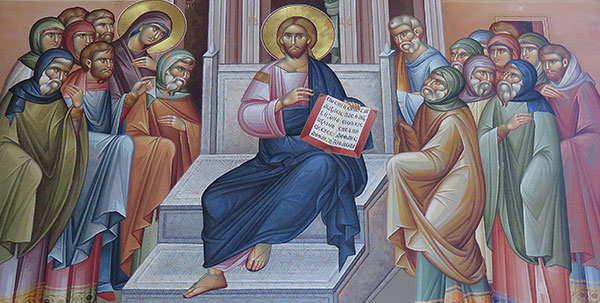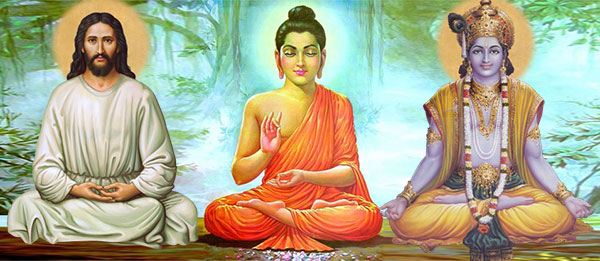Toward the end of his mission in Israel, Jesus asked his disciples: “What think ye of Christ?” (Matthew 22:42).
It is a sad but true fact that the teachings of any master or world-teacher are misunderstood even during his life, and after his departure from this world there is a steady degeneration and distortion of his teachings until what remains is unrecognizable. It is rare that the teachings of a master survive even one generation unmarred. Many fundamental distortions of Jesus’ teachings in the first three centuries created a religion far from His original message.
The masters are always aware of the tenuous nature of their precepts. That is why Jesus, speaking of His future rebirth in this world, asked His disciples: “When the Son of man cometh [again], shall he find faith on the earth?” (Luke 18:8). “Many will say to me in that day, Lord, Lord, have we not prophesied in thy name? and in thy name have cast out devils? and in thy name done many wonderful works? And then will I profess unto them, I never knew you: depart from me, ye that work iniquity” (Matthew 7:22, 23).
 Many times Paramhansa Yogananda said to his disciples: “When I am gone you will all change everything.” The first time I went into the bookstore at the Hollywood center in 1961, I met one of Yogananda’s first New York City disciples, Annie Vickerman, the wife of Warren Vickerman, Yogananda’s second American disciple. In our conversation she said: “Master more than once said to Vickie [her husband] and myself: ‘After three generations you will not even know I came to this country.’ When we asked him what use his coming here was, he told us: ‘I have planted a seed and it will grow. My work will go on, even if my name is not mentioned.’”
Many times Paramhansa Yogananda said to his disciples: “When I am gone you will all change everything.” The first time I went into the bookstore at the Hollywood center in 1961, I met one of Yogananda’s first New York City disciples, Annie Vickerman, the wife of Warren Vickerman, Yogananda’s second American disciple. In our conversation she said: “Master more than once said to Vickie [her husband] and myself: ‘After three generations you will not even know I came to this country.’ When we asked him what use his coming here was, he told us: ‘I have planted a seed and it will grow. My work will go on, even if my name is not mentioned.’”
Confusion about Christ
One of the most harmful deviations from the original teachings of Jesus was the confusing of Jesus with Christ. “Christ” and “Christ Consciousness” are designations of Ishwara, the Lord, the personal creator aspect of God (Brahman). As an ordinary Christian I never met anyone who understood the doctrine of the Trinity and could speak a single intelligent sentence about it. But when I read the writings of Paramhansa Yogananda it was not just clear, it was simple.
The Father is Brahman the transcendent absolute; the Son, the Only-Begotten, is Ishwara, the guiding consciousness within creation; the Holy Spirit is the Holy Breath, the intelligent Light from which all things are formed, Maha Shakti or Prakriti, the Mother aspect of God. The Trinity is not “three Persons” but three modes of existence in relation to the evolving consciousness that is the Self or Atman. God is absolutely One, but can manifest in a myriad ways. He is not confined by His unity to the simplistic monotheism of Western religions. After all, Jesus was a missionary to the West, teaching the wisdom of the Eternal Religion (Sanatana Dharma) He had learned in India.
The Aquarian Gospel
Although it is only a little over a century old, the only correct and complete presentation of the life and teachings of Jesus is The Aquarian Gospel of Jesus the Christ by Levi Dowling. There the right perspective on the Christ (Ishwara) and a Christ (a liberated master or avatar) is clearly shown.
“The news soon spread abroad that Jesus, king of Israel, had come to Bethany, and all the people of the town came forth to greet the king. And Jesus, standing in the midst of them, exclaimed, Behold, indeed, the king has come, but Jesus is not king. The kingdom truly is at hand; but men can see it not with carnal eyes; they cannot see the king upon the throne. This is the kingdom of the soul; its throne is not an earthly throne; its king is not a man” (Aquarian Gospel 68:1-4).
“Men call me Christ, and God has recognized the name; but Christ is not a man. The Christ is universal love, and Love is king. This Jesus is but man who has been fitted by temptations overcome, by trials multiform, to be the temple through which Christ can manifest to men. Then hear, you men of Israel, hear! Look not upon the flesh; it is not king. Look to the Christ within, who shall be formed in every one of you, as he is formed in me. When you have purified your hearts by faith, the king will enter in, and you will see his face” (Aquarian Gospel 68:11-14).
Every sentient being is destined to become a Christ, and that is the subject of this chapter of Theologia Germanica.
The Christ-soul
Let us remember how it is written and said that the soul of Christ had two eyes, a right and a left eye. In the beginning, when the soul of Christ was created, she fixed her right eye upon eternity and the Godhead, and remained in the full intuition and enjoyment of the divine Essence and Eternal Perfection; and continued thus unmoved and undisturbed by all the accidents and travail, suffering, torment and pain that ever befell the outward man. But with the left eye she beheld the creature and perceived all things therein, and took note of the difference between the creatures, which were better or worse, nobler or meaner; and thereafter was the outward man of Christ ordered. (From Theologia Germanica)
We are all Christs by nature, but to manifest that nature requires the most exalted spiritual status. For us to attain that condition, God extended or emanated Himself as Ishwara, the Son of God, the Christ. Here the priest is describing both this archetypal soul (psyche) and the soul of one who has attained Christhood–in this case the soul of Jesus.
The Christ-soul (Christ-psyche) has the ability to perceive the eternal and the temporal, the absolute and the relative, simultaneously and unceasingly. As the Bhagavad Gita says: “That yogi sees me in all things, and all things within me. He never loses sight of me, nor I of him” (Bhagavad Gita 6:30). Such a one knows who and what he is–both divine and human. He lives in consciousness of his real being, and so is never distracted or unbalanced by the miseries of the world.
“When, through the practice of yoga, the mind ceases its restless movements, and becomes still, he realizes the Atman. It satisfies him entirely. Then he knows that infinite happiness which can be realized by the purified heart but is beyond the grasp of the senses. He stands firm in this realization. Because of it, he can never again wander from the inmost truth of his being. Now that he holds it he knows this treasure above all others: faith so certain shall never be shaken by heaviest sorrow. To achieve this certainty is to know the real meaning of the word yoga. It is the breaking of contact with pain. You must practice this yoga resolutely, without losing heart” (Bhagavad Gita 6:20-23).
The Christ-soul possesses the wisdom of viveka, of discrimination between the real and the unreal, the true and the false, and the real life it lives in God as well as the false life it lives in the world. There is no “childlike” naivité in such a one, but profound insight into the level and nature of everything they encounter in the relative world. The liberated not only know themselves, they know others equally well and do not fear to say what they see.
Thus the inner man of Christ, according to the right eye of his soul, stood in the full exercise of his divine nature, in perfect blessedness, joy and eternal peace. But the outward man and the left eye of Christ’s soul, stood with him in perfect suffering, in all tribulation, affliction and travail; and this in such sort that the inward and right eye remained unmoved, unhindered and untouched by all the travail, suffering, grief and anguish that ever befell the outward man.
It has been said that when Christ was bound to the pillar and scourged, and when he hung upon the cross, according to the outward man, yet his inner man, or soul according to the right eye, stood in as full possession of divine joy and blessedness as it did after his ascension, or as it doth now. In like manner his outward man, or soul with the left eye, was never hindered, disturbed or troubled by the inward eye in its contemplation of the outward things that belonged to it. (From Theologia Germanica)
A Christ such as Krishna, Buddha and Jesus, lives in the state known as Brahmanishtha or Brahmastithi–being established in the consciousness of the Absolute Brahman, dwelling in that consciousness unbrokenly and unwaveringly.
The Soul of the Yogi
The ordinary human soul which has not attained the status of a son of God is either in the consciousness of the material world or in the realm of the spirit. The yogi lives in both to some degree, but always one predominates. The experience of the spiritual world affects him profoundly and results in his living the life of the world with the spiritual perspective that transforms his mode of life in the world and his reaction to it. More and more “this corruptible must put on incorruption, and this mortal must put on immortality. So when this corruptible shall have put on incorruption, and this mortal shall have put on immortality, then shall be brought to pass the saying that is written, Death is swallowed up in victory” (I Corinthians 15:53, 54).
For the yogi, life increases day by day as death fades away day by day until only the divine life remains and he is free. Then the two “eyes” have become one, seeing as God sees, not as man sees. Then his eye is “single” as we have seen earlier in this study. Living the state of unity he sees only unity, but a unity that embraces the dualities in the relative planes of life. Since the world comes from God, embodies the will of God and is evolving back to God, eventually the “left eye” merges into the “right eye” and the “masters” that seemed dual and antithetical earlier are seen to be but the One. Then the Christ-soul has become god, has become a perfect reflection-image of the Father, the Son and the Holy Spirit, trinity in unity and unity in trinity.
More from Theologia Germanica:
- How Can You Know God?
- When Will Perfection Come for Us?
- Seeing Our Spiritual Blindness That We Can Overcome It









